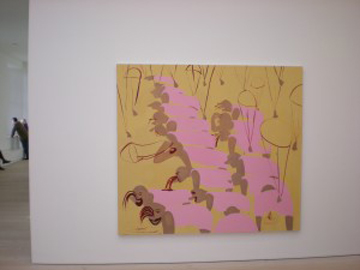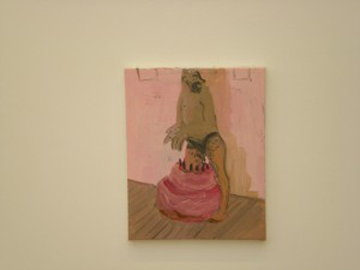
Tala Madani, "Nosefall," 2007 (photo: Ben Street)
Sometimes working in or around contemporary art can be a bit embarrassing. When the papers are splashed with the latest case of a work of art being mistaken for rubbish and thrown out, or an artist’s work being bought for $45m by a cackling oligarch, or an artist being given an award for teaching a children’s choir to sing Stalininst anthems, those of us who work in or around contemporary art are put in a position of having to defend our natural inclinations. Sometimes admitting to working in or around contemporary art can be like admitting to having a collection of He-Man figurines in their original wrapping, arranged thematically in filing cabinets in the garden shed. It can feel like an eccentricity, like breeding pigeons. This may be why an architecture of carefully-structured and neurotically-guarded cool is built around it, and why it has its own carefully-maintained technical vocabulary, and its own carefully-delineated bibliographies and reference points; it’s a retreat, a defense mechanism. It may also be why shows like the Tate’s survey of contemporary art, Altermodern, and the Whitney’s biennials, and the New Museum’s opening show Unmonumental (to name but three of many, and it’s worth noting their nomenclative kinship, with its feigned lightness, its passive-aggressive self-deprecation), feel not limitless and open but careful, tasteful, guarded.
Explosions of tastelessness are what art needs every so often, now more than ever. Looking at work by painter Tala Madani in the Saatchi Gallery’s new so-so survey of Middle Eastern art (clunkily entitled Unveiled), I was reminded of the great moments of tastelessness in art history—moments when prevailing orthodoxies were pushed head down into the grime of shameless crudeness and willful grotesqueness. Philip Guston’s (now, not then) celebrated switch from phantom abstraction to Krazy Kat slapstick at the end of the 60s is most tellingly resonant in Madani’s paintings, but the ghosts of tacksters past are all over the work: Caravaggio’s dirty-fingernailed Bacchuses with their baskets of rotten fruit, James Ensor’s carnivalesque parades of gibbering goons, even Kara Walker’s finessed filth and nimble-fingered nastiness.
As she is Iranian-American, a prerequisite of a piece on Tala Madani is that it start with an allusion to her Iranian heritage, but the really interesting thing about Madani is how her work plugs into the heritage of bad taste painting and drags it out of its burrow to face the confusing and paranoiac daylight of the early 21st century. Madani paints, on scales both huge and tiny, with a quick, slippery stroke and a restricted, fleshy pallette, scenes of middle-aged Middle Eastern men engaged in absurdist mini-dramas of violence, eroticism, and embarrassment. A hirsute, bare-chested man in a black Speedo steps gingerly into a tiered pink cake, looking around him in a comic display of belated secrecy. A barrel-chested man has his beard plaited by another, and ends up looking like a parodied Alice, complete with pink bow. Even Madani’s off-hand squiggly brushwork has a kind of embarrassment about it, as though reluctant to flesh out these grotesque characters, to give them too much life.

Tala Madani, "Diving in Cake," 2006 (photo: Ben Street)
On a large scale, Madani’s works take on a kind of heraldic abstraction, patterning ochre and off-white surfaces with repeated figurative motifs. Men (always men) on all fours in hot pink unitards are deployed across the paintings, their sketched-in parachutes the only nod to their terrorist associations. In Nosefall, a group of men crouching in what might be (judging by the parachutes) a plane on the way to a civilian target, get an attack of altitude nosebleeds and clutch their faces frustratedly; a couple turn towards the viewer, grinning sheepishly. It’s not just their deconstructed-Rubens pallette (pinks, browns, yellows) that these works share with the late Guston: both artists revel in the humor (and pathos) intrinsic to society’s bad guys, whether KKK or Taliban. Madani’s paintings wear their artistic heritage lightly—there’s an echo of golden age Matisse in the larger works, especially the mighty Moroccans —but do something rare and cherishable in ostensibly “political” art: they muddy the waters, giving certainty the slip. Neither critical nor affectionate, Madani’s paintings play an attraction-repulsion game endemic to the business of painting itself.
That evening, I actually told someone I’m a contemporary art fan without apologizing. What a relief.



